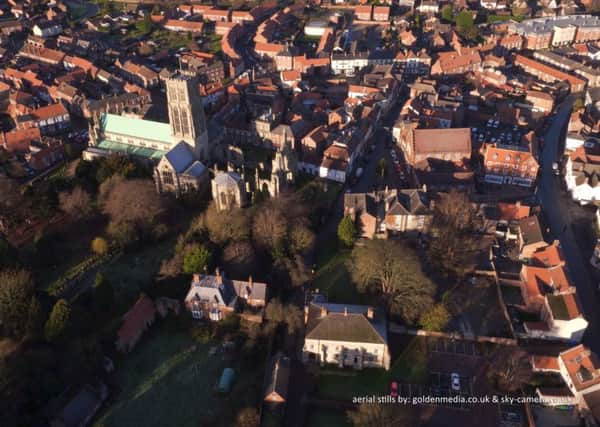The search to find a Yorkshire market town's '˜lost' palace


During medieval times, the East Yorkshire market town of Howden had a level of significance and influence that belies its size and stature today. Now a group of local people are determined to unearth secrets from its illustrious past by embarking on an archaeological dig at a hugely important site in the town centre.
Once famous throughout Europe for its horse fair, which was the largest in the country, Howden was given to the Bishops of Durham by William the Conqueror, who built a vast palace on a site close to the town’s Minster. According to Dr Jon Kenny of Community Archaeology, an independent organisation that specialises in supporting community projects, the town’s location close to the River Ouse allowed the Prince Bishops of Durham to wheel and deal – Game of Thrones-style – with the important medieval players in Yorkshire, as well as royalty.
Advertisement
Hide AdAdvertisement
Hide AdHowden’s significance waned after the Reformation and a survey of the bishops property carried out in the seventeenth century described how the palace had fallen into disrepair. Only the Great Hall survives today; it’s known as Bishops Manor and is used as an events venue. The surrounding buildings either fell down or were demolished centuries ago.
When he began volunteering at Howden Heritage Centre, which opened last year in the town’s Market Place in a project initiated by Howden Civic Society, Mike Hatfield, a retired photographer, came up with the idea of staging an archaeological dig on land to the rear of the building. The unassuming plot of land, which has never been excavated before, is located next to Bishops Manor and, intriguingly, is where some of the long-lost buildings that formed part of the vast palace complex once stood. They were set around a central courtyard, which would have been located on what’s now a lawned area at the front of Bishops Manor.
“When work was being carried out on the flats above the Heritage Centre, one of the workmen was looking for the drains and found a rock,” says Mike. “When I cleaned it up and showed it to experts, they confirmed that it was evidence of a medieval glass furnace, although it’s not clear whether it was made there or brought in.
“The site is of great archaeological interest; there are medieval bricks in the wall that stands between the dig site and the lawn at the front of Bishops Manor. Thankfully, the land owner has kindly given his permission for the dig to go ahead.”
Advertisement
Hide AdAdvertisement
Hide AdLocal historian Susan Butler offers an insight into the scale of the palace complex. “By the fourteenth century, it had a great hall, which is now the Manor House, as well as bishop’s lodgings, a private chapel, servants’ rooms and storage buildings.”
It’s known that a number of these buildings occupied the parcel of land that will be excavated by the community-led archaeological dig, giving Mike and his fellow volunteers high hopes of unearthing medieval artefacts. Working together, they have wasted no time in getting the backing of English Heritage, East Riding of Yorkshire Council and Community Archaeology.
Dr Jon Kenny jumped at the chance to get involved and is convinced that the dig will reveal more of the medieval palace that once stood next door to Howden Minster.
“In 2014, I had the opportunity to work with a team of community volunteers to investigate the north-west side of Bishops Manor,” says Jon.
Advertisement
Hide AdAdvertisement
Hide Ad“We also peered across a wall into the overgrown gardens to the east of the manor that we see today.
“If only we had the chance to look there,” we said; that’s where the manor parlour, chapel and bishop’s lodgings should be. Well now, that wish is being granted thanks to the work of Mike Hatfield and his team.”
Although experts will oversee every aspect of the dig, Mike is keen to give as many local people as possible the chance to get involved. “We definitely want to involve local schools, but there will be a role for anyone who wants to help. Even those who can’t do the more physical work can sieve through soil or wash and record details of any items found.”
Jon agrees: “This is a really exciting opportunity for a community team to investigate the ‘lost’ part of Bishops Manor and put it on the map.
Advertisement
Hide AdAdvertisement
Hide Ad“I am so pleased to be able to support them and look forward to getting many different people from the community, of all kinds of skills, ages and abilities, involved in different aspects of the project, bringing Bishops Manor to the attention of all.”
Work on the project is expected to get under way this summer, but the dig is likely to take up to five years to complete and will be tackled in 10 metre square sections. Mike and his fellow volunteers are applying for grants to help fund the project, as well as seeking sponsorship and donations of useful tools and equipment, such as spades, shovels and event fencing, from local businesses.
It’s hoped that any interesting artefacts found on the site will go on display in Howden Heritage Centre and that, once the excavation work is complete, the dig site can be turned into a heritage garden for local people to enjoy. Another of Mike’s bright ideas came to him during a trip to Melrose in the Scottish Borders, where he saw a similar development.
“The area surrounding the palace is known to have been surrounded by orchards in its medieval heyday and I thought it would be nice to replant the site with native fruit trees to create a heritage garden, which could be accessed from the back door of the Heritage Centre.”
And in doing so, help bring a little bit of history to life.